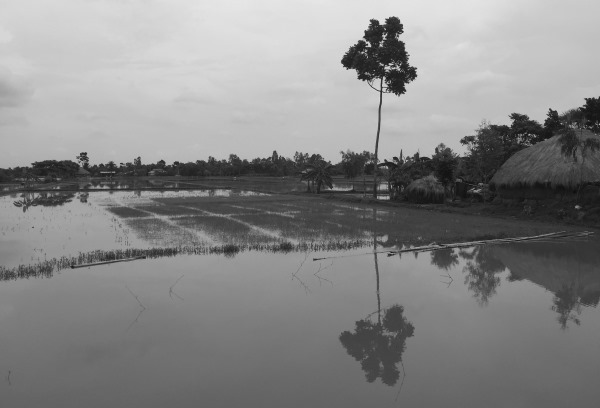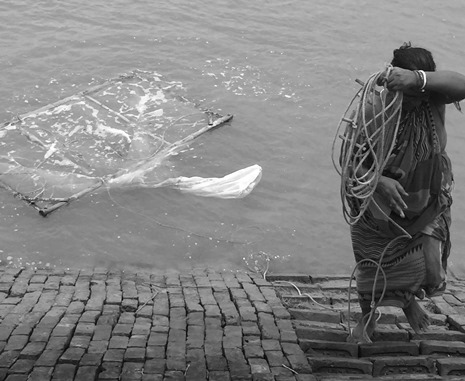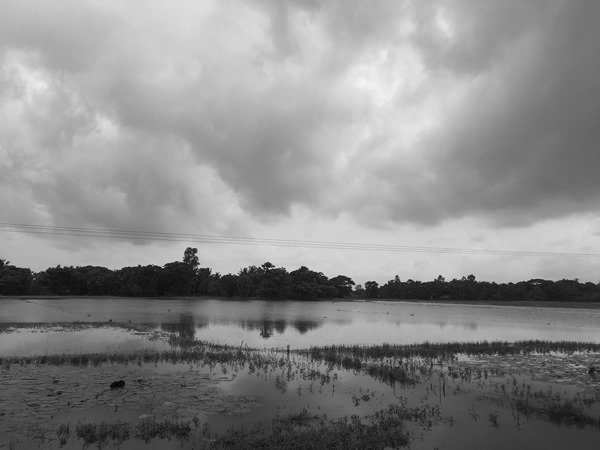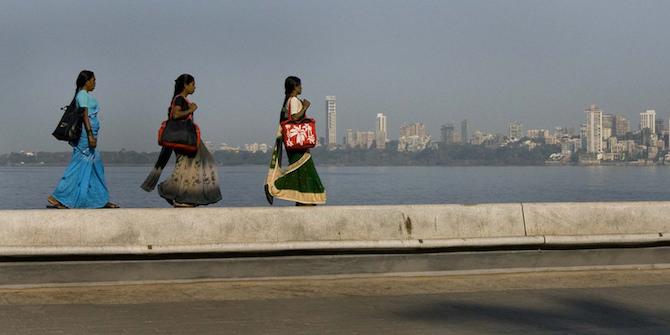
 Drawing on their field research in West Bengal, Lexi Aisbitt and Humaira Chowdhury offer an insight into the mixed blessing that is the monsoon for people with precarious livelihoods in eastern India. While the rains offer relief from the summer heat, nourishment to crops and a boost to water levels in the rivers and ponds used by fishermen, unpredictable climate patterns can also have a devastating impact.
Drawing on their field research in West Bengal, Lexi Aisbitt and Humaira Chowdhury offer an insight into the mixed blessing that is the monsoon for people with precarious livelihoods in eastern India. While the rains offer relief from the summer heat, nourishment to crops and a boost to water levels in the rivers and ponds used by fishermen, unpredictable climate patterns can also have a devastating impact.
“a terrain where the boundaries between land and water are always mutating, always unpredictable…” (Amitav Ghosh: The Hungry Tide)
In eastern India, the monsoon has arrived, removed its coat and comfortably settled in. For the past month or so, as elsewhere across the country, rain has intermittently caressed, spotted and lashed the land and its inhabitants. At the fringes of West Bengal on the edge of the Sundarban archipelago, the landscape has undergone a dramatic transformation. As the rains gather pace, the previously parched and sun scorched earth has given way to flooded fields of shimmering silver, of rivers and ponds spilling their banks.
Whilst the rains for many bring a celebrated relief from the searing summer heat, for those whose lives are inextricably intertwined with water, their arrival is more complex. For those leading precarious livelihoods that are dependent on, or beholden to, the ponds, rivers and waterlogged fields that compose this littoral environment, the monsoon rains and changes they bring are both desired and cursed.
In a village near the Bidhyadhi river, a man is giving his cow a leisurely bath in a now full, verdantly surrounded pukur (pond). Emerging from the water in his sodden dhoti, he explains the benefits of the rains for the couple of dairy cows he owns, upon whose milk he depends to make a living. “It is very good for their health” he says smiling, as he smacks the rump of the largest cow. The now plentiful water supply means that livestock are both able to eat better and stay healthy, thus improving the quality of the milk and the price at which it can be sold. How often does the bovine bathing ritual take place? “Every three days” he says, as the small group trundle off down the path to their homestead.
For others living in this village, the new abundance of water is only troublesome. With only a handful of pukka brick built houses in the sprawling community of about 6,000 homes, the challenge of protecting houses built from earth from the rising water, violent storms and increasing mud is a daily battle. “I hate the rains” the wife of the local Imam says simply, as she tries to shift the thick mud surrounding the entrance to her small home from encroaching on the steps. Her brothers-in-law, all farmers, have been unable to work in their fields for the past two days due to the unceasing rains. Though water is needed for the rice crops farmed by many in the area, the water levels are currently excessive, destroying any chance of successful cultivation, leaving no choice for farmers but to wait and worry.
Nearby, a local fishing community living huddled along an uneven brick path by the side of the river Hogol have their own complex relationship with water. We watched as a woman prepared to cast her fishing net into the river, walking gingerly down the bund (raised quay), and carefully navigated her way to the surface of the river, armed with the large net in her hands. Like many others in the region, she is invested in catching badga-maach, the largest Indian marine prawn to be farmed. The tidal river where she works, though a primary source of subsistence for local communities, is simultaneously a physical and economic threat due to its temperamental nature and erratic tidal patterns.
Men and women here are forced to fish every day, with men taking boats to the middle of the churning river whilst women stay close to the embankment. Fishing patterns depend on the river’s ebb and flow, the height of the tide and favourable weather conditions. Nets are placed in the river during periods of high tide, and are sedulously pulled out against the current of the river at low tide, with the help of a rope tightly fastened to their wooden frames. This becomes particularly precarious when the water level recedes, due to the difficulty of navigating the rocky embankment in bare feet in order to strategically place the net into the crocodile and snake infested water.
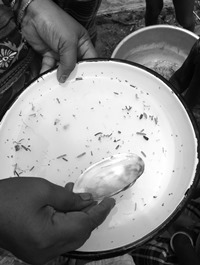 Showing us her catch from the day so far, the challenge of this work was made stark. Min-bagda, otherwise known as tiger-prawn seedlings, are about 9-14mm in size resembling tiny strands of hair. Once caught, they are transferred to a large bowl and will be painstakingly separated from the aquatic detritus by hand with the help of a sea-shell, the most laborious part of the whole process. An average collection of 1000 tiny bagdas a day gives this woman a paltry sum of 200 Indian rupees, or £2 for 16 hours of work.
Showing us her catch from the day so far, the challenge of this work was made stark. Min-bagda, otherwise known as tiger-prawn seedlings, are about 9-14mm in size resembling tiny strands of hair. Once caught, they are transferred to a large bowl and will be painstakingly separated from the aquatic detritus by hand with the help of a sea-shell, the most laborious part of the whole process. An average collection of 1000 tiny bagdas a day gives this woman a paltry sum of 200 Indian rupees, or £2 for 16 hours of work.
The violent storms of monsoon can prevent fishing and mean no money earned that day, whilst the unpredictable climate patterns and geographical isolation of these fishing communities has a heavy bearing on their lives. Marked by poverty, uneven development in the region, vulnerability to natural disasters, they lead precarious lives, living cheek by jowl in a shifting terrain that is constantly shaping and reshaping their everyday livelihoods.
On a train back to Kolkata, the glistening landscape unfurls on either side. Houses lie marooned in vast fields of water, abandoned by their inhabitants unable to stem the rising water. Farmers wade waist deep through water, checking the status of their chal or rice crop that will determine their ability to survive the coming months. As the monsoon rains continue for the next two months, those living in this low lying delta of India will continue to praise and to curse water, all the while treading the fine line of survival.
All images by Lexi Aisbitt
Note: This article gives the views of the author, and not the position of the South Asia @ LSE blog, nor of the London School of Economics. Please read our comments policy before posting.
About the Authors
 Lexi Aisbitt is a doctoral candidate in LSE’s Department of Anthropology, currently conducting ethnographic fieldwork in West Bengal.
Lexi Aisbitt is a doctoral candidate in LSE’s Department of Anthropology, currently conducting ethnographic fieldwork in West Bengal.
 Humaira Chowdhury has a Masters in Sociology and is applying for PhD programmes this year. She has worked on several research projects in Kolkata, and is currently conducting ethnographic research near the Sundarbans.
Humaira Chowdhury has a Masters in Sociology and is applying for PhD programmes this year. She has worked on several research projects in Kolkata, and is currently conducting ethnographic research near the Sundarbans.


